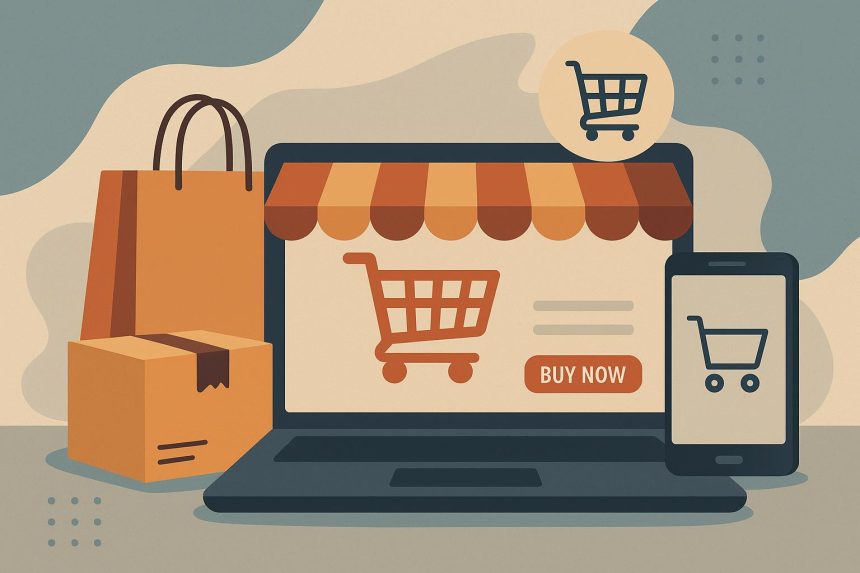Online shopping has become a cornerstone of modern retail, fundamentally shifting how consumers approach purchasing. While it’s common to hunt for deals and discounts, the methods are evolving as rapidly as the technology itself. Many consumers now seek savings sites such as Latest Deals, where they can find offers that cater to their unique needs. Let’s explore how these changes are influencing the future of online shopping.
The Rise of Personalization in Shopping
Gone are the days of one-size-fits-all shopping. Today, online sellers are channelling their effort into creating hyper-personalized experiences for consumers. Think of your most recent online shopping trip – how many times did you see products recommended just for you? Or special deals that seemingly read your mind? No coincidence, buddy, that’s personalization at work.
The tech behind this personalized approach? Artificial Intelligence (AI) and Machine Learning (ML). These technologies analyze your previous searches, clicks, and purchases to recommend products that you might want to add to your cart next. Essentially, they’re becoming your shopping buddies who know your taste perfectly, albeit in an uncanny way.
User-specific deals tailored to your shopping behaviour and preferences, also part of this trend, help in driving customer loyalty and increasing conversions. You’re more likely to use a coupon if it hits your sweet spot, rather than a generic promo code flying around, right?
The driving force behind this shift towards more personalized shopping experiences is the value it offers to consumers; it’s like walking into a store where every rack only displays what you love. This approach benefits businesses too, as it boosts conversions, increases customer retention, and ultimately, ups the sales game.
To sum it up, personalization is leaving the realm of ‘extra feature’ and stepping into the ‘absolute necessary’ territory in online shopping. And with AI and ML powering the journey, the landscape of personalized shopping is only set to become more precise, more intuitive, and more, well, personal.
Mobile Shopping: Convenience at Your Fingertips
The Rise of Mobile Shopping
In today’s always-connected, on-the-go society, mobile shopping has taken center stage as the preferred shopping method for many consumers. In fact, it’s as common as grabbing a cup of Joe on the way to work.
Why Mobile Shopping?
Why are more people turning to their smart devices for their purchasing needs? The answer lies in its unparalleled convenience.
- 24/7 Availability: Browse the latest fashion trends while commuting, compare gadget prices during lunch breaks, or score the best deals on home essentials right before lights out.
- Seamless User Experience: Mobile apps and shopping platforms prioritize user-friendliness with smooth transitions from the virtual storefront to the checkout cart, all within a few swipes and taps.
Features of Mobile Shopping Platforms
Mobile shopping is not all about availability. There are several features that enhance the shopping experience:
- Easy Comparison: Built-in features allow easy comparison of prices, product specs, and customer reviews.
- Informed Decisions: Shoppers can make informed decisions without leaving the app.
- Personal Shopping Experience: It’s like having a personal shopping assistant, price checker, and product critic all in one place.
The Future of Mobile Shopping
Technology continuously raises the bar for shopping convenience. Now, more than ever, the future of retail is at our fingertips. With new technologies continuing to reshape mobile shopping platforms, the possibilities are endless:
- One-Touch Shopping
- Shoppable Digital Closets
- Fully Realized 3D Shopping Experiences
It’s as exciting as it sounds. So, sit back, relax, and enjoy the ride – the mobile shopping revolution has only just begun.
Social Shopping: The Power of Influence
The digital landscape is no longer just about connecting with friends or sharing photos from your latest getaway. It, too, has molded into a bustling marketplace shaped by the relationships and networks we’ve cultivated. Enter the realm of social shopping, a potent mix of e-commerce and social media that is redefining how we make purchasing decisions.
We all love a good endorsement from our peers, don’t we? Such endorsement could be your buddy giving you a thumbs-up for that new trainer brand or your fashion-forward coworker raving about their recent buys from an online boutique. In the social shopping world, these endorsers are influencers—individuals with legions of loyal followers, whose word is often taken as gospel.
Influencers are now key players in online shopping. They hold significant sway over their followers, backed by the trust they’ve built over time. When they sport a new hairstyle, use a particular skincare product, or even get their hands on the latest tech gadget, their followers are keen to replicate their choices. Influencers’ recommendations have become a modern form of word-of-mouth marketing, resulting in a radical shift in buying patterns. This phenomenon isn’t just limited to big-name celebrities; nano-influencers, those with smaller yet engaging followings, also play a considerable part in this burgeoning trend.
But the influence isn’t merely a one-way street; social platforms themselves are evolving to accommodate this new wave of e-commerce. More and more social media apps, like Instagram and Facebook, are introducing in-app shopping features, crafting seamless bridges between browsing feeds and checking out carts. Platforms such as Pinterest are no longer just sources of inspiration but have transformed into full-fledged shopping destinations.
The impact of social commerce is undeniable. It’s changing the game for both consumers and retailers, breaking down traditional purchasing barriers and blending consumer experiences across different platforms. But for all its promise, it’s still an evolving beast, set to shape and be shaped by the ever-changing consumer landscape. And as it grows, one thing is certain: the reign of social shopping is just beginning. Get on board, or risk being left behind.
Sustainability: The Conscious Consumer
We can’t talk about the future of online shopping without acknowledging one game-changing trend: Sustainability. Today’s consumers are increasingly valuing businesses that go beyond the bottom line, seeking purchases that align with their socially and environmentally-conscious values.
Changing Consumer Priorities
- Beyond Deals and Shipping: It’s no longer just about flashy deals or overnight shipping. Consumers are interested in:
- The origin of the product,
- How it’s made,
- Ethical practices,
- Eco-friendly production,
- Responsible waste management.
- Demand for Transparency: Transparency in production and sourcing is now a key component of purchasing decisions. Shoppers want assurance that their dollars are not supporting damaging practices but are instead influencing a more sustainable future.
Retailer Response and Pressure
- Adaptation to Consumer Demands: This shift in consumer consciousness is prompting retailers to:
- Evaluate supply chains,
- Identify carbon footprints,
- Strive towards fair trade certification.
- Risk of Ignoring Sustainability: Brands that ignore these demands risk losing savvy consumers who are willing to research and prioritize sustainable solutions.
Examples and Innovations
- Stellar Examples: Current offerings include:
- ‘Eco-friendly’ products,
- Ethical sourcing verification,
- ‘Carbon offset’ shipping choices.
Conclusion
In a nutshell, whilst the digital age has boomed our shopping options, it has also given rise to informed, engaged consumers who care about more than just price tags. The future of online shopping will inevitably be greener, as customers continue to vote with their wallets and shape retailer strategies.
Virtual Reality and Augmented Reality: Shaping the Future
Welcome to the new age of online shopping, where Virtual Reality (VR) and Augmented Reality (AR) are revolutionizing the e-commerce landscape. These technologies are no longer limited to the realm of gamers; they’re adding a whole new dimension to how we shop online.
The Role of Augmented Reality in Shopping
AR technology is transforming the traditional shopping experience and eliminating buyer hesitation with its immersive features.
- Virtual Placement:
- Allows you to “place” furniture or decor items in your space using your smartphone camera.
- Provides a realistic preview, easing uncertainty about product suitability.
- Try-Before-You-Buy Concept:
- Experience products in your actual environment without physical hassle.
- Reduces returns and increases customer satisfaction.
Virtual Reality’s Impact on E-Commerce
VR is enhancing the online shopping experience by bringing the perks of physical shopping to the digital world.
- Simulated Store Navigation:
- Use a VR headset to explore virtual stores.
- Pick up and inspect products from various angles, just like in a physical store.
- Enhanced Product Exploration:
- Offers an immersive experience, replacing the typical click-and-scroll method.
- Encourages a deeper connection with products.
The Future of E-Commerce with VR and AR
Where is all this leading? Picture a world where you can:
- Virtually try on clothes.
- Accessorize your home.
- Shop for groceries, all from your couch.
While this vision is still developing, it’s becoming increasingly attainable.
Conclusion
The fusion of VR and AR in e-commerce promises significant transformations. These early days hint at a future where the line between physical and online shopping blurs, creating an intuitive and engaging consumer experience. So, strap on a headset, explore what’s already possible, and get excited about what’s on the horizon.
The Role of Fast Delivery Services
Fast delivery services have turned into the golden tickets of modern e-commerce, significantly impacting customer decisions. It’s no more a hidden secret: we’re an impatient species, especially when it comes to online shopping. The appeal of the “Buy Now” button loses its charm if it’s followed by a long wait for the product to be delivered. As consumers, we’re getting increasingly accustomed to – and expectant of – quick shipments, and often rank sellers based on this speed.
In an era of instant gratification, same-day and next-day delivery services have skyrocketed. Giants like Amazon are not simply offering these services as a bonus; it’s a reflection of user expectations. Even smaller e-commerce platforms have scrambled, swiftly shifting their strategies to stay competitive in terms of delivery speed.
However, offering these speedy services isn’t without its hurdles. It requires an intricate, well-oiled logistics operation. From warehouse management to transportation efficiency, there’s a vast back-end machinery that has to perform seamlessly to get that purchase to your doorstep overnight. Sometimes, things can go off the rails. Unexpected hiccups, like weather-related issues or sudden spikes in orders, can throw a wrench in the works.
Even then, the field of logistics hasn’t just accepted these challenges lying down. Innovations continue to emerge, powering the arena to tackle these difficulties head-on – from evolving warehouse technologies, AI-driven route optimization to drone deliveries.
In conclusion, the magic behind the speed of delivery services isn’t just about fulfilling a consumer’s impatience. It’s about maintaining customer satisfaction, fostering loyalty, and holding a competitive place in the online shopping landscape. It’s a bold testament to the lengths to which retailers can go to elevate your shopping experience. And as it seems, they’re only just getting started.
Conclusion: Embrace the Change
In this mad rush of technological advancements and changing consumer behavior, the world of online shopping is evolving at a pace that is both thrilling and slightly daunting. Here’s how the landscape is changing:
Key Developments in Online Shopping
- Personalized Shopping Experiences
- Artificial intelligence is shaping these experiences.
- Shopping is tailored to individual needs.
- Mobile Shopping
- Fits conveniently into our pockets.
- The ease and accessibility are unmatched.
- Social Commerce
- Driven by social media personalities.
- The allure of trends makes it a sociocultural phenomenon.
The Conscious Consumer
- Sustainability Focus
- Consumers demand sustainable options.
- Brands are called upon to exhibit ethical practices.
- Consumer Power
- Shaping retailer strategies to align with ethical and sustainable practices.
Innovative Shopping Experiences
- Virtual and Augmented Realities
- Virtual reality transports us to different realms.
- Augmented reality integrates these realms into our daily lives.
Fast Delivery Services
- Competitive Edge
- Lightning-fast delivery services are a must.
- Retailers push the boundaries of logistics to meet consumer demand.
The accelerated changes in the global online shopping scene are an exciting reality check: they point to a future that is here and now. It’s more crucial now than ever for consumers and retailers alike to embrace this change. Mate, it’s not just about staying ahead in the game, but enjoying the game as it’s being reinvented. Because, after all, change is the only constant – let’s ride this wave together.
Tweet
🔎 Ever wondered how those spot-on shopping recommendations pop up? It’s all about the rise of personalized shopping fueled by AI & ML! Discover how this trend is reshaping the retail world. Dive into the article for all the details!
Lynn Martelli is an editor at Readability. She received her MFA in Creative Writing from Antioch University and has worked as an editor for over 10 years. Lynn has edited a wide variety of books, including fiction, non-fiction, memoirs, and more. In her free time, Lynn enjoys reading, writing, and spending time with her family and friends.















